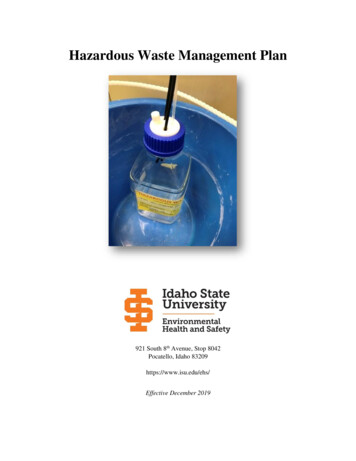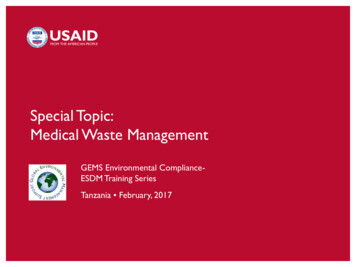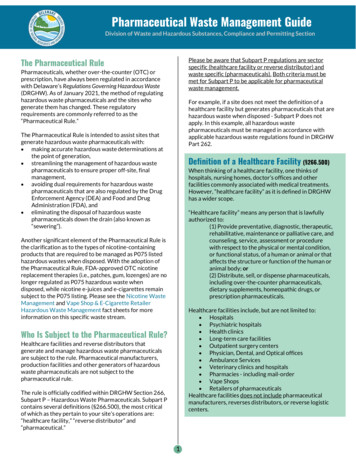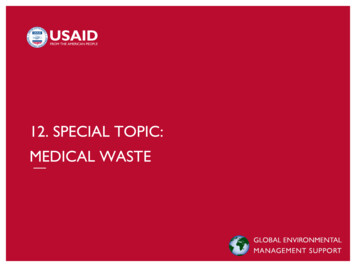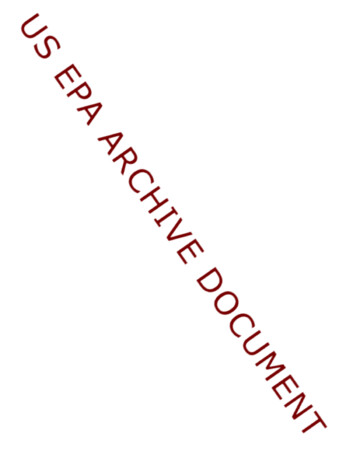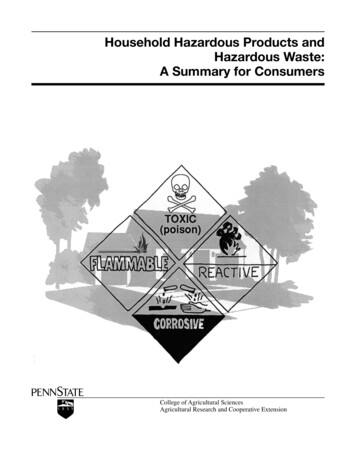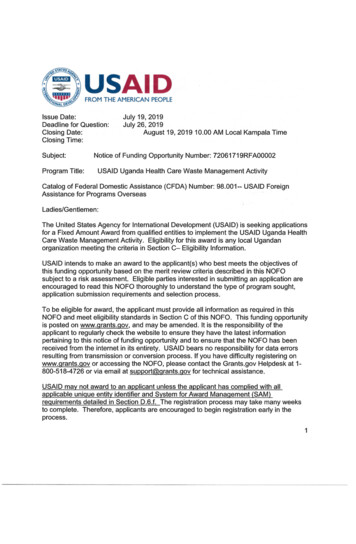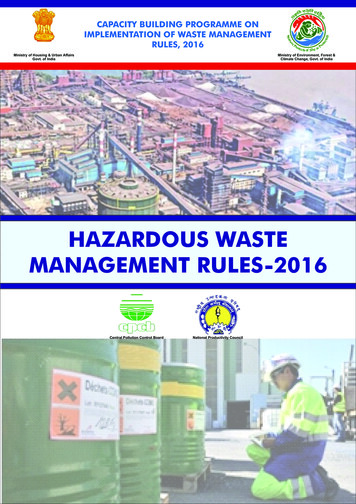
Transcription
CAPACITY BUILDING PROGRAMME ONIMPLEMENTATION OF WASTE MANAGEMENTRULES, 2016Ministry of Housing & Urban AffairsGovt. of IndiaMinistry of Environment, Forest &Climate Change, Govt. of IndiaHAZARDOUS WASTEMANAGEMENT RULES-2016Central Pollution Control BoardNational Productivity Council
HAZARDOUS & OTHER WASTES(MANAGEMENT AND TRANSBOUNDARY MOVEMENT)RULES, 2016Overview ofHazardous &Other WasteManagementFeatures ofHazardousWasteRules 2016Du es ofstakeholdersManagement &Recycling ofHazardous wasteYour Guide ForHAZARDOUS & OTHER WASTES1st Edi onJune, 2019
PrefaceNa onal Produc vity Council (NPC) presents the Tool Kit is pleased to present to youthe 'Toolkit for implementa on of Hazardous Waste Management rules, 2016'. Thistoolkit has been cra ed specially for reference forby all the the stakeholders involvedin the genera on, collec on, storage, transporta on, treatment & disposal ofHazardous waste. Further, it is published as a reference for ci zens , ins tu onsinterested to explore and understand the key features of the rules no fied in 2016.The tool kit describes Hazardous Waste Classifica on and Operatorss' Requirements,aspects of Import & Export of Hazardous & Other Wastes, Record keeping,Hazardous Waste Generator Training Requirements, Disposal of Hazardous waste.It provides useful ps, FAQs, do's and don'ts, methods and prac ces that should befollowed in the Hazardous solid waste management process.The toolkit has been brought together by a team of good technocrats andenvironmentalists, including from various regulatory authori es in the country. Ithas beenfurthercarefully reviewed by experts.This toolkit also provide Standard Opera ng Procedures (SOP)s for management ofavailable specific Hazardous Waste.NPC would welcome any sugges ons and feedback on this publica on so that 'TheToolkit' becomes a usefultrusted companion & compendium for reference bystakeholders in Indiaand part of all Stakeholders.K. D. BhardawajRegional Director, DelhiNa onal Produc vity Council
Compiled & Edited by:Na onal Produc vity CouncilNote:1. All pictures used in the toolkit are from various sources, which have been duly referred to.2. This publica on is purely for educa on purpose and not for commercial purpose.
ABBREVIATIONSAPCD – Air Pollu on Control DeviceCHWTSDF – Common Hazardous Waste Treatment, Storage & Disposal FacilityCPCB – Central Pollu on Control BoardDRE – Destruc on & Removal EfficiencyEPA – Environment Protec on AgencyETP – Effluent Treatment PlantEU – European UnionFAQ – Frequently Asked Ques onsGHG – Green House GasesHOWMTM – Hazardous & Other Wastes Transboundary MovementHW – Hazardous WasteKLPD – Kilo Liter Per DayLQG – Large Quan ty GeneratorMOEF&CC – Ministry of Environment, Forest & Climate ChangeMTA – Million Tons per AnnumPPE – Personneal Protec on EquipmentSPCB – State Pollu on Control BoardSOP POP – Standard Proposed Opera ng ProcedurePrac ceSLF – Secured Landfill FacilitySQG – Small Quan ty GeneratorSTLC – Soluble Threshold Limit Concentra onTCLP – Toxicity Characteris c Leaching ProcedureTTLC – Total Threshold Limit Concentra onTPA – Tonnes Per AnnumTSDF – Treatment, Storage & Disposal FacilityUSEPA – United States Environment Protec on Agency
Table of ContentsS. No. Content12.3Page No.Introduc on11.1Hazardous Waste Policy Framework41.2Hazardous Waste Defini on4Hazardous Waste Classifica on and Operators Requirements52.1How to Iden fy Hazardous & Other Wastes82.2Responsibili es of Occupier92.3Storage Requirements102.4Labeling Requirements112.5Hazardous Waste Accumula on/Storage Area112.6Hazardous Waste Compa bility122.7Container Management15Import & Export of Hazardous & Other Wastes153.1Responsibili es of Importer163.2Procedure for Export of Hazardous & Other Wastes from India163.3Illegal Traffic164Record keeping185Hazardous Waste Generator Training Requirements185.1Training Requirements for Small Quan ty Generators (SQG)185.2Training Requirements for Large Quan ty Generators (LQG)195.3Training Plan1967Hazardous & Other Waste Management206.1Waste Minimiza on/Cleaner Produc on226.2Co-processing of Hazardous Waste246.2.1 Benefits of Co-processing in Cement Industry256.2.2 Material & Energy Recovery266.2.3 Best Prac ces of Hazardous Waste u liza on other than Co-processing29Disposal307.1Quality Management System317.2Se ng up of Common Hazardous Waste Treatment, Storage and Disposal32Facili es (CHWTSDF)
8Hazardous Waste Emergency/Con ngency Plan388.1General Requirements388.2Use of Con ngency Plan388.3Emergency Communica on398.4Emergency Response Equipment39Appendix – A: Important Defini ons40Appendix – B: List of Hazardous Characteris cs as per Rules, 201643Appendix – C: Proposed Opera ng Prac ces47Appendix – D: Frequently Asked Ques ons (FAQs)77Appendix – E: Do’s and Don’ts85Appendix – F: Forms as per Rules, 201688
1.0INTRODUCTIONRapid industrializa on in last fewrecent decades have led to the deple on of natural resources andincrease in pollu on in the country. As part of economic development, this industrializa on hasalso led to genera on of huge quan es of hazardous waste which causes severe environmentalproblems. These industrializa on has also led,apart from economic development, to thegenera on of huge quan es of hazardous waste which causes sewer environmental problems.Therefore, scien fic treatment and systema c disposal of generated waste is a necessity.Hazardous waste is a complex problem as it poses threat not only to the environment but also tothe human health. It requires sophis cated and specialized treatment due to the presence of amixture of chemicals and substances. Basically, the hazardous wastes are generated because of thefollowing reasons:a)Use of Hazardous Substances:- Generally, most of the hazardous wastes are generated duringthe produc on and consump on and produc on of chemicals. The genera on of such wastesis increasing with the increase in the demand of the consumer goods.b)Use of Inappropriate Technologies:- Many industries, in par cular small & mediumenterprises (SMEs) use outdated or obsolete technologies due to economic and technicalconstraints. As a result the resource conversion is not op mum, resul ng in high & more toxicand/or hazardous wastes.c)End of Pipe Treatment of Effluent/Emissions:-The treatment of wastewater streams andgaseous emissions to meet the standards, result into residues that contain hazardouscons tuents.Ministry of Environment, Forest and climate Change (MoEF & CC) formerly known as Ministry ofEnvironment and Forest (MoEF) promulgated Hazardous Waste (Management and Handling)Rules, 1989, under the provision of the Environment Protec on Act, 1986. In September 2008 thesaid rules were amended and new rules en tled “Hazardous waste (Management, Handling andTransboundary Movement) Rules, 2008” were promulgated. These rules were further amended inthe year 2009 & 2010 for proper management and handling of hazardous waste in the country(CPCB, 2010-2011). India has also ra fied the Basel conven on on transboundary movement ofhazardous waste in the year 1992 and is a signatory to the conven on (Du a SK, 2006). It is aninterna onal treaty that was designed to reduce the movements of hazardous waste betweenna ons, except where it is perceived to be in accordance with principles of environmentally soundmanagement. The rules have been further amended recently, en tled Hazardous and OtherWastes (Management and Transboundary Movement) Rules, 2016, to include other wastes such asWaste tyre, paper waste, metal scrap, used electronic items, etc.As per the CPCB es mates in 2010latest sta s cs, about 7.66 million tonnes per year of hazardouswaste is generated from about 40,722 industries. About 3.39 MTPA (44.3%) landfillable; 3.61MTPA (47.2%) recyclable and 0.65 MTPA (8.5%) is incinerable waste, out of the total hazardous1
waste generated in the country. About 83% of total hazardous waste isn generated from in sevenstates viz.; Gujarat, Maharashtra, Tamil Nadu, Andhra Pradesh, West Bengal and Cha sgarh. Thereare about 29 Common Secured Landfill Facili es in 16 states and 14 Common Incinerators in 7states in order to manage hazardous wastes in environmentally sound manner.As per the Compendium of Environmental Sta s cs India, 2016, about 90% of the total hazardouswaste generated in the country is being contributed by ten (10) states and out of these, theindustries in three states viz.; Maharashtra, Gujarat and Andhra Pradesh contribute about 60% oftotal hazardous waste. Most of the hazardous waste is being generated from chemical produc on& metal processing industries apart from the treatment of wastewater and flue gases.The state wise hazardous waste genera on along with percentage recyclable is presented in thefollowing Table – 1 and Figure – 1 & 2.Table – 1.0 : State wise Hazardous Waste Genera on in IndiaHazardous Waste Genera on in India (MTPA)StatesHW Genera on(MTPA)% RecyclableMaharashtra1.8158.4Gujarat1.7932.2Andhra Pradesh1.0957.9Rajasthan0.7923.9Tamil Nadu0.434.8Madhya Pradesh0.3788.8Cha sgarh0.2968.4Jharkhand0.2486.1U ar Pradesh0.2176West Bengal0.274.52
Figure – 1.0: Showing Hazardous Waste Genera on in IndiaFigure – 21.1 : Percentage of Recyclable waste in various States.This Hazardous & Other Wastes Rules, 2016, Compliance Tool Kit is intended to assist variousstakeholders in understanding how to comply with the regula ons governing hazardous wastemanagement in India and to manage hazardous wastes in environmentally sound manner.The tool kit provides the Do's and Don'ts with respect to management of hazardous waste. Itprovides several proposed opera ng prac cesgeneral standard opera ng procedures (PSOPs) thatcan be customized and adapted as per the individual requirement.3
1.1HAZARDOUS WASTE POLICY FRAMEWORKHazardous waste was first regulated in 1989 through Hazardous Waste (Management & Handling)Rules, 1989, which subsequently were amended in 2008 to incorporate Basel Conven onprovisions and lastly recently again in 2016. The Hazardous Waste Management regula ons haveundergone sea change since its first promulga on in 1989 to take care of requirements of variousstakeholders from me to me. Hazardous Waste is regulated by the following agencies in India:····Ministry of Environment, Forest & Climate Change, Government of India;Central Pollu on Control Board;State Pollu on Control Boards andPollu on Control Commi ees1.2HAZARDOUS WASTE DEFINITIONWhat is Waste?“Waste" means materials, that are not products or byproducts, for which the generator has nofurther use for the purposes of produc on, transforma on or consump on. Wastes are thematerials that may be generated during, the extrac on of raw materials, the processing of rawmaterials into intermediates and final products, the consump on of final products, and throughother human ac vi es and excludes residuals recycled or reused at the place of genera on. Byproduct means a material that is not intended to be produced but gets produced in the produc onprocess of intended product and is used as such.What is Hazardous Waste?The primary purpose for a hazardous waste defini on is to help the stakeholders establish whetherwaste is hazardous or poten ally hazardous. As per Hazardous and Other Wastes (Managementand Transboundary Movement) Rules, 2016:“Hazardous waste” means any waste which by reason of characteris cs such as physical, chemical,biological, reac ve, toxic, flammable, explosive or corrosive, causes danger or is likely to causedanger to health or environment, whether alone or in contact with other waste or substances andshall include:i.Wastes specified in column (3) of Schedule-I;ii.Wastes having equal to or more than the concentra on limits specified for the cons tuents inClass A and Class B of Schedule-II or any of the characteris cs as specified in Class C ofSchedule II; andiii.Wastes specified in Part-A of Schedule-III in respect of import or export of such wastes or thewastes not specified in Part A but exhibits hazardous characteris cs specified in Part-C ofSchedule-III4
The possible effects of hazardous waste are uncertain and vary greatly, depending on the natureand volume of the substance and the receiving environment. However, if managed improperly, thepossible effects from toxic and hazardous substances on humans, animals and plants include:“ mortality; adverse effects on reproduc on; causing cancer; causing deformi es and gene cmuta ons; causing other diseases; accumula on in the environment and living ssue (this mayhave consequences in the food chain); indirect effects on ecosystems”.2.0HAZARDOUS WASTE CLASSIFICATION & OPERATOR REQUIREMENTSWaste is considered a hazardous waste based on proper es that make it poten ally dangerous orharmful to human health or the environment. It can be a liquid, solid, contained gases, or discardedunused commercial product, or discarded used material.Various characteris cs have been defined under Class 'C' of Schedule II and Part 'C' of Schedule IIIof Hazardous and Other wastes, Rules, 2016. Waste is considered hazardous if it shows one or moresome of the following characteris cs:Flammable or Ignitable: A waste exhibits the characteris c of flammability or ignitability if arepresenta ve sample of the waste has any of the following proper es, namely:(I)flammable liquids, or mixture of liquids, or liquids containing solids in solu on orsuspension (for example, paints, varnishes, lacquers, etc; but not including substances orwastes otherwise classified on account of their dangerous characteris cs), which give off aflammable vapour at temperature less than 60 C.This flash point shall be measured as per ASTM D 93-79 closed-cup test method or asdetermined by an equivalent test method published by Central Pollu on Control Board;(ii)it is not a liquid and is capable, under standard temperature and pressure, of causing firethrough fric on, absorp on of moisture or spontaneous chemical changes and, whenignited, burns vigorously and persistently crea ng a hazard;(iii)it is an ignitable compressed gas;(iv)It is an oxidizer and for the purposes of characterisa on is a substance such as a chlorate,permanganate, inorganic peroxide, or a nitrate, that yields oxygen readily to s mulate thecombus on of organic ma er.Easily catches on fire. Examples include: petroleum products, pes cides, solvents, etc.Corrosive: A waste exhibits the characteris c of corrosivity if a representa ve sample of the wastehas either of the following proper es, namely:(i)it is aqueous and has a pH less than or equal to 2 or greater than or equal to 12.5;(ii)it is a liquid and corrodes steel (SAE 1020) at a rate greater than 6.35 mm per year at a test5
temperature of 55 C;(iii)it is not aqueous and, when mixed with an equivalent weight of water, produces a solu onhaving a pH less than or equal to 2 or greater than or equal to 12.5;(iv)it is not a liquid and, when mixed with an equivalent weight of water, produces a liquid thatcorrodes steel (SAE1020) at a rate greater than 6.35 mm per year at a test temperature of55 C.Note:For the purpose of determining the corrosivity, the Bureau of Indian Standard 9040 C method forpH determina on, NACE TM 01 69 : Laboratory Corrosion Tes ng of Metals and EPA 1110Amethod for corrosivity towards steel (SAE1020) to establish the corrosivity characteris cs shall beadopted.Causes deteriora on, etching, or ea ng away of body ssue and other surfaces that it touches.Examples include: acids & alkalis.Toxic- A waste exhibits the characteris c of toxicity, if, :(i)the concentra on of the waste cons tuents listed in Class A and B (of this schedule) areequal to or more than the permissible limits prescribed therein;(ii)it has an acute oral LD50 less than 2,500 milligrams per kilogram;(iii)it has an acute dermal LD50 less than 4,300 milligrams per kilogram;(iv)it has an acute inhala on LC50 less than 10,000 parts per million as a gas or vapour;(v)it has acute aqua c toxicity with 50% mortality within 96 hours for zebra fish (Brachidaniorerio) at a concentra on of 500 milligrams per litre in dilu on water and test condi ons asspecified in BIS test method 6582 – 2001.(vi)it has been shown through experience or by any standard reference test- method to pose ahazard to human health or environment because of its carcinogenicity, mutagenecity,endocrine disrup vity, acute toxicity, chronic toxicity, bio-accumula ve proper es orpersistence in the environment.Toxic: Poisonous and may cause injury or death if swallowed, inhaled, or absorbed through theskin. Examples include: insec cides, paints, heavy metals.Reac ve or explosive- A waste exhibits the characteris c of reac vity if a representa ve sample ofthe waste it has any of the following proper es, namely:(i)it is normally unstable and readily undergoes violent change without detona ng;(ii)it reacts violently with water or forms poten ally explosive mixtures with water;(iii)when mixed with water, it generates toxic gases, vapours or fumes in a quan ty sufficient topresent a danger to human health or the environment;6
(iv)it is a cyanide or sulphide bearing waste which, when exposed to pH condi ons between 2and 12.5, can generate toxic gases, vapours or fumes in a quan ty sufficient to present adanger to human health or the environmental;(v)it is capable of detona on or explosive reac on if it is subjected to a strong ini a ng sourceor if heated under confinement;(vi)it is readily capable of detona on or explosive decomposi on or reac on at standardtemperature and pressure;(vii)it is a forbidden explosive.Reac ve: Reac ve wastes are unstable under normal condi ons. They can cause explosions orrelease toxic fumes, gases, or vapors when heated, compressed, or mixed with water. Examplesinclude: phosphorous, sodium metal.Substances or Wastes liable to spontaneous combus on - Substances or Wastes which are liableto spontaneous hea ng under normal condi ons encountered in transport, or to hea ng up oncontact with air, and being then liable to catch fire.Substances or Wastes which, in contact with water emit flammable gases- Substances or Wasteswhich, by interac on with water, are liable to become spontaneously flammable or to give offflammable gases in dangerous quan es.Oxidizing - Substances or Wastes which, while in themselves not necessarily combus ble, may,generally by yielding oxygen cause, or contribute to, the combus on of other materials.Organic Peroxides - Organic substances or Wastes which contain the bivalent O O structure, whichmay undergo exothermic self-accelera ng decomposi on.Poisons (acute) - Substances or Wastes liable either to cause death or serious injury or to harmhuman health if swallowed or inhaled or by skin contact.Infec ous substances - Substances or Wastes containing viable micro-organisms or their toxinswhich are known or suspected to cause disease in animals or humans.Libera on of toxic gases in contact with air or water - Substances or Wastes which, by interac onwith air or water, are liable to give off toxic gases in dangerous quan es.Eco-toxic- Substances or Wastes which if released, present or may present immediate or delayedadverse impacts to the environment by means of bioaccumula on or toxic effects upon bio csystems or both.Capable, by any means, a er disposal, of yielding another material, e.g., leachate, which possessesany of the characteris cs listed above.Note: Products can show more than one characteris c, for example wastes from dyes & dyeintermediate, dis lla on residues may be toxic, flammable and corrosive. In such cases, one needto put symbol for the most predominant cons tuent in the waste.7
Figure – 2.0: Sample symbolic representa onShowing of selectedCharacteris cs of Hazardous Wastes.2.1 How to Iden fy Hazardous Waste?Iden fica on of waste as hazardous is a first and foremost aspect in hazardous wastemanagement. An occupier must first iden fy whether the waste they generate is a hazardouswaste. Hazardous waste can be difficultto iden fy. It may not be immediatelyobvious that the waste you are handlingis poten ally hazardous. Figure 1 belowis designed to help you determinewhether or not the waste you aremanaging is hazardous as per theHazardous and Other Wastes(Management and TransboundaryMovement) Rules, 2016.Note: An occupier can also choose torely on professional exper se todetermine whether the waste is ahazardous waste or by sending thewaste to a cer fied laboratory fortes ng and analysis.8
Is the waste solid , semi solidor liquid form or contained ?Is the waste listed in Schedule I-List ofProcesses genera ng Haz. Wastes ?NoYesDoes the waste exceeds conc limits ofwaste cons tuents based on TCLP orSTLP listed in class A of Schedule IINoYesDoes the waste exceeds conc limits ofwaste cons tuents based on TTLClisted in class B of Schedule IINoYesIs the waste classified as perHazardousCharacteris cs listed inclass C of Schedule IINoYesWaste is a Hazardous WasteWaste is not aHazardous WasteFigure 2.1: Flowchart for determina on of hazardous waste as per Rules 20162.2Responsibili es of OccupierCertain responsibili es have been rested on theoccupier of hazardous and other wastes generator forsafe and environmentally sound management ofhazardous wastes star ng from pollu on preven on tosafe disposal. The occupier is required to follow thefollowing steps:-pollu on preven on;-waste minimiza on;-3 R concept (reuse, recycle and recovery);9
-U liza on including co-processing of hazardous wastes in other industries as raw materialsor as a fuel subs tute;-Efficient treatment and safe disposal;-Hazardous waste & other wastes shall be sent or sold to an authorized actual user ordisposed in an authorized disposal facility only;-Shall transport wastes through an authorized or cer fied transporter to an authorizedactual user or to an authorized disposal facility as per the provisions of these rules;-Shall provide specific informa on to TSDF for treatment and disposal, as required for safestorage and disposal;-Shall take all the steps to contain contaminants and prevent accident & limit theirconsequences on human beings and the environment;-Shall provide persons working with appropriate training, equipment and the informa onnecessary to ensure their safety;-Shall make an applica on in Form 1 (Appendix E) to the SPCB for Grant of authoriza on formanaging hazardous and other wastes along with copies of Consent to establish underWater and Air Acts. In case of renewal of authoriza on, a self-cer fied compliance report ofeffluent, emission standards and the condi ons specified in earlier authoriza on ofhazardous & other wastes;-Shall make renewal applica on three months before the expiry of authoriza on;2.3Storage RequirementsThe occupiers of facili es genera ng hazardous &other wastes may store for a period of not more thanninety (90) days and a maximum quan ty of ten (10)tonnes. The State Pollu on Control Board may extendthe said period of ninety days in the following cases:a.Small generators (up to ten tonnes per annum)up to one hundred and eighty (180) days oftheir annual capacity;b.Actual users and disposal facility operators upto one hundred and eighty (180) days of their annual capacity;c.Occupiers who do not have access to any TSDF in the concerned State; ord.The waste which needs to be specifically stored for development of a process for itsrecycling, recovery, pre-processing, co-processing or u liza on;e.In any case on jus fica on grounds up to one hundred and eighty (180) days;10
2.4Labeling RequirementsThe occupier must mark the hazardous waste containers with the labels as specified in Form 8(Appendix E) of the Rules with fluorescent yellow colour background wri en in RED words as‘HAZARDOUS WASTES’ and ‘HANDLE WITH CARE’ in Hindi, English and vernacular language. Theword ‘OTHER WASTES’to be wri en prominently in orange in Hindi, English and vernacularlanguage.Waste Category and characteristics asIncompatible wastes andsubstances per Part C of Schedule II & III ofRules .Total Quantity .Date of Storage .Physical State of the waste (Solid/Semi-solid/liquid):‘HAZARDOUS WASTES’‘HANDLE WITH CARE’OR‘OTHER WASTES’Sender’s name and addressReceiver’s name and addressPhone Phone E-mail .E-mail .Tel. and Fax. No .Tel. and Fax. No .Contact Person .Contact Person .In case of Emergency please Contact .Figure – 2.4: Sample for Labeling of Containers of Hazardous and Other Wastes.2.5 Hazardous Waste Accumula on/StorageAreaIn a large establishment where a number of wastes are beinggenerated, an area be designated as a storage area known ascentral hazardous waste accumula on area. This is an areawhere hazardous wastes are accumulated prior to being pickedup for treatment, recycling or disposal. Requirements for theseareas include:-The accumula on area must be locked or protectedfrom unauthorized entry. A fence around the area is not required if it is in an area that is11
already restricted from unauthorized personnel.-Containers must be labeled with the appropriate hazardous waste label.-There must be appropriate signage iden fying the area as hazardous waste storage, and a“No Smoking” signage.-Weekly inspec ons must be conductedat these areas using the weeklyinspec on checklist.-There must be sufficient aisle space toallow unobstructed movement ofpersonnel, fire protec on equipment,spill control equipment, anddecontamina on equipment to any areaof the opera on.The following equipment must be easily accessible, in working condi on, and regularly tested:-Internal communica ons or alarm system capable of providing immediate emergencyinstruc on to personnel.-Telephone or hand-held two-way radio capable of contac ng local and emergencyresponders.-Portable fire ex nguishers and fire control equipment, including special ex nguishingequipment (foam, inert gas, or dry chemicals).-Fire hydrants or other source of water (reservoir, storage tank, etc.) with adequate volumeand pressure, foam producing equipment, automa c sprinklers, or water spray system.-Spill control equipment.-Secondary containment for liquid wastes.2.6 Hazardous Waste Compa bilitySome types of chemicals (based on their chemicalproperty /characteris c) when they come into contactwith chemicals they are not compa ble with can causechemical reac ons that could create a hazardousreac on. This could involve the produc on of toxic gas,accelerated corrosion, or an exothermic reac on (achemical reac on that releases heat), which could resultin an explosion and/or fire.Even though hazardous waste is stored in containers,12
there is a risk of mixing if there is a material spill/release due to lack of proper storage or if there is anatural disaster that can cause a release of chemicals.It is therefore important to understand what types of chemicals are compa ble to store togetherand which are not compa ble, so as to avoid mixing of incompa ble chemicals.Below is a general guidance describing which types of chemicals/materials should not be mixed orstored nearby.Keep the following materials segregated from each other:-Acids and bases (for example lead acid ba eries and caus c cleaners)-Flammables or combus bles and oxidizers (for example paint thinner and bleach)-Corrosives and flammables or combus bles (for example acid cleaners and oil)When storing hazardous wastes, it is important that the waste is not placed in containers made ofmaterials that could pose compa bility issues like those men oned above. For example, do notplace acids in metal drums because the acid will corrode the container and cause a leak.The following chemical compa bility chart would help occupier to iden fy non-compa blechemicals in their wastes.Table -– 12.6.1: Chemical Compa bility ChartGroup 1-AGroup 1-BAlkaline LiquidsAcid LiquidsPoten al consequences: Heat genera on, violent reac onGroup 2-AGroup 2-BAluminumAny waste in Group 1-A or 1-BBerylliumCalciumMagnesiumSodiumOther reac ve metals and metal hydridesPoten al consequences: Fire or explosion genera on of flammable hydrogen gasGroup 3-AGroup 3-BAlcoholsAny concentrated waste in Groups 1-A or 1-BWaterCalciumLithium13
Metal hydridesPotassiumSO2Cl2, SOCl2,Pcl3,CH3SiCl3Other water-reac ve wastesPoten al consequences: Fire, explosion, or heat genera on; genera on of flammable or toxicgasesGroup 4-AGroup 4-BAlcoholsConcentrated Group 1-A or 1-B wastesAldehydesGroup 2-A wastesHalogenated hydrocarbonsNitrated hydrocarbonsUnsaturated hydrocarbonsOther reac ve organic compounds and solventsPoten al consequences: Fire, explosion, or violent reac onGroup 5-AGroup 5-BSpent cyanide and sulfide solu onsGroup 1-B wastesPoten al consequences: Genera on of toxic hydrogen cyanide or hydrogen sulfide gasGroup 6-AGroup 6-BChloratesAce c acid and other organic acidsChlorineConcentrated mineral acidsChloritesGroup 2-A wastesChromic acidGroup 4-A wastesHypochloritesOther flammable and combus ble wastesNitratesNitric acid, fumingPerchloratesPermanganatesPeroxidesSource: (From Boston Univ. Medical Center)Note: When in doubt consult the Material's Safety Data Sheet (MSDS) to iden fy chemicalproper es and hazard warnings.14
Good Practices for Hazardous Waste (HW) Handling & Storage:- Maintain the containers in good condition and immediatelyreplace leaking ones;- Keep the HW containers closed at all times except whenremoving the waste;- Never Avoid fill the lineto the top of any container containingliquid HW and allow at least 5 cm of air space near the top tocontrol inside vapour pressure;- Follow working procedures & instructions regarding the safehandling & emergency response;- Use the designated personal protective equipment (PPE);2.7Container ManagementThe following are requirements for hazardous waste containers:-Containers must be compa ble with the waste in them.Containers must be kept closed except when waste is actually being added or removed.Containers must not be leaking, bulging, rus ng, damaged, or dented.Store liquid waste containers on secondary containment pallets.For Large Quan ty Generators Only
The primary purpose for a hazardous waste definion is to help the stakeholders establish whether waste is hazardous or potenally hazardous. As per Hazardous and Other Wastes (Management and Transboundary Movement) Rules, 2016: "Hazardous waste" means any waste which by reason of characteriscs such as physical, chemical,
